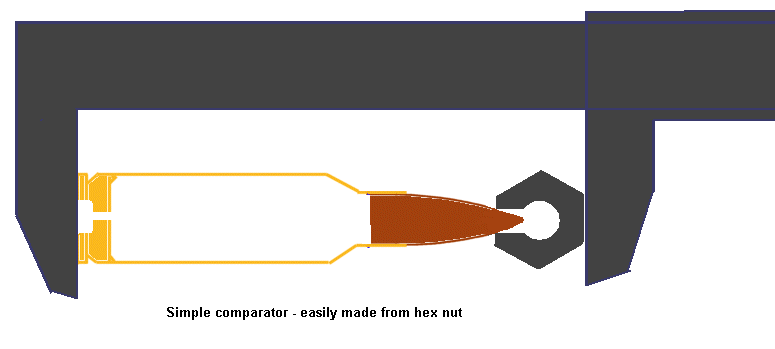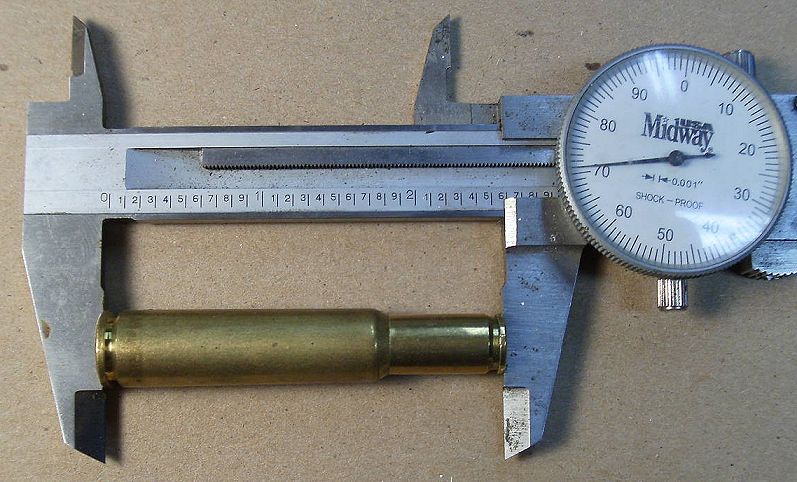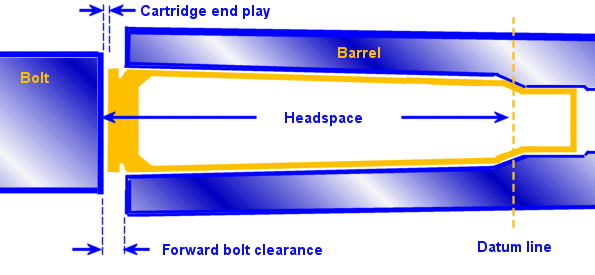-
FREE MEMBER
NO Posting or PM's Allowed

measuring head space
I don't have a 7.62 head space gauge and was wondering...can I take the extractor and spring out of the bolt head,firing pin and spring out of the bolt body, chamber a dummy round and then reasonably get an idea of the headspace by inserting a feeler gauge between the receiver and the locking nub where the bolt handle is?
Is it dangerous to have head space too tight, as in forcing the bolt handle down the last inch? Watching someone else shooting with this issue, it didn't seem to affect the shooting but I kept the shooters bodies between the gun and me...lol, this coward will live a long time, or at least longer...
Information
 |
Warning: This is a relatively older thread
This discussion is older than 360 days. Some information contained in it may no longer be current. |
|
-
09-22-2009 03:54 AM
# ADS
Friends and Sponsors

-
Advisory Panel


Having headspace too tight will accelerate wear in the locking lugs, and it can also lead to very tightly jammed cases.
What rifle are you concerned about? If its a No4 actioned 7.62mm conversion with a proper 7.62mmm extractor and proof mark, then chances are that the rifle is in spec from the time it was initially set up.
If its an Ishapore 2A1, its a bit pointless measuring it because there is no published headspace data available - you have to look at the thousands of 2A1s out there and take the chance that your won't be the very first one to exhibit some sort of problem....
-
-
FREE MEMBER
NO Posting or PM's Allowed

Its a 1966 2a1...I want to check it because over the course of a year I mixed the bolt head with a box of others, no1mk3's and 2 ishy 7.62. I'm worried its way off spec but don't know how to check it without the gauge. Looking at the bolt heads and extractors kind of didn't help, they all look the same very quickly. I chose the one with the extractor reaching deepest across the face. Do ishapore have any signature stamps on their bolt heads? If anything its a firm close, probably better than too loose I hope The rounds pull and eject without problems.
Thanks for help, I confess to being a bit worried about this as I share my guns on the day with other people and never ever want to have a safety issue show up.
Last edited by RJW NZ; 09-22-2009 at 07:29 AM.
-
If I was you, just get any of the bog standard 7.62mm had spece gauges from the L1A1, L4 series, GPMG etc etc and they'll all be pretty well around/between the 1.628 - to 1.645 sizes. They using your known gauge as a datum, you'll be able to ascertain the rifle CHS with a degree of/sort of certainty. Not scientific of course but better than the squashed shell-case method!
I'm sure that someone in NZ will loan you one of the smaller sizes. But here's a tip. Before you insert it and snap the bolt closed on it, always remove the extractor becaus even if you don't do it the first time, you will eventually snap a bit of the rim off. That's because Armourers don't like anyone who knackers their carefully preserved, cherished and looked after gauges!
will loan you one of the smaller sizes. But here's a tip. Before you insert it and snap the bolt closed on it, always remove the extractor becaus even if you don't do it the first time, you will eventually snap a bit of the rim off. That's because Armourers don't like anyone who knackers their carefully preserved, cherished and looked after gauges!
-
-
FREE MEMBER
NO Posting or PM's Allowed

RJW NZ ........
........
This is my first post on this forum. It's a very good idea to measure your chamber clearance (at the shoulder), and see how YOUR handloads fit in YOUR particular chamber. That's why I developed the Digital Headspace Gauge.
It's best to keep your headspace to a minimum, like -.002" or less. Unlike the RCBS Precision Mic, our Digital Headspace Gauge works on ALL calibers. Unlike the Stoney Point tool (now Hornady) our gauge doesn't require using a collection of bushings to operate, and you also don't need to balance your cases on the blade of calipers to measure a case.
- Innovative
-
-
-
FREE MEMBER
NO Posting or PM's Allowed

Parashooter .........
Your method works well. In fact, that's how I used to do it. However, I designed our new Digital Headspace Gauge to be far less rickety. As a bonus feature it can also help locate your seating depth by measuring back from the bullet ogive.
The stem of the gauge provides uniform downward pressure against the tapered shoulder for the most consistent measurements, and it's a lot easier to use.
- Innovative
-
Advisory Panel


For the ~.30 calibers, a .25 ACP or .22 rimfire case can serve the ogive-comparator function, but a drilled hex nut is easier to handle. Undoubtedly "rickety" but also very low-cost.

Judging from what I've observed, there will always be a certain market for good tools even when their function can be performed with adequate precision and convenience by no-cost improvisations. Some folks just love buying nice gear and shun the homegrown alternatives.
-
-
FREE MEMBER
NO Posting or PM's Allowed

Parashooter .......
The "hex nut" tool is another good idea when you're starting out, and saving money defnitely is a very good idea. However, when you're serious about shooting, it's best to advance to using better tools and get away from the rickety stuff. Today there are lots of reloading tools available. I recently came across a catalog with two pages of similar reloading tools. However, you would have had to purchase almost all of them to do the same functions as our Digital Headspace Gauge.
Our company is directly involved with shooters. We listen to see what products are needed, and we make them affordable. We also pursue products that larger companies don't manufacture due to the expense of R&D and manufacturing.
- Innovative















 Register To Reply
Register To Reply














